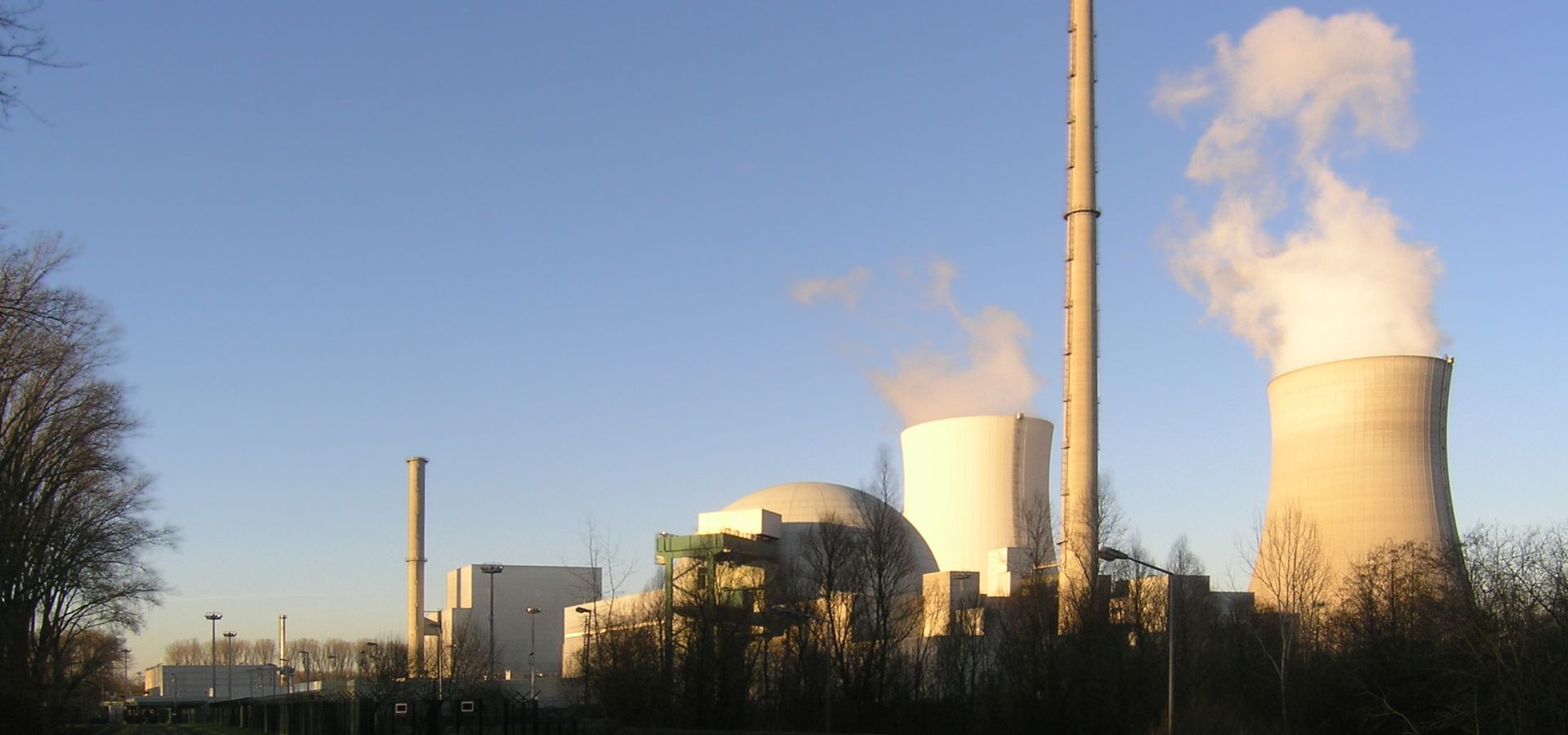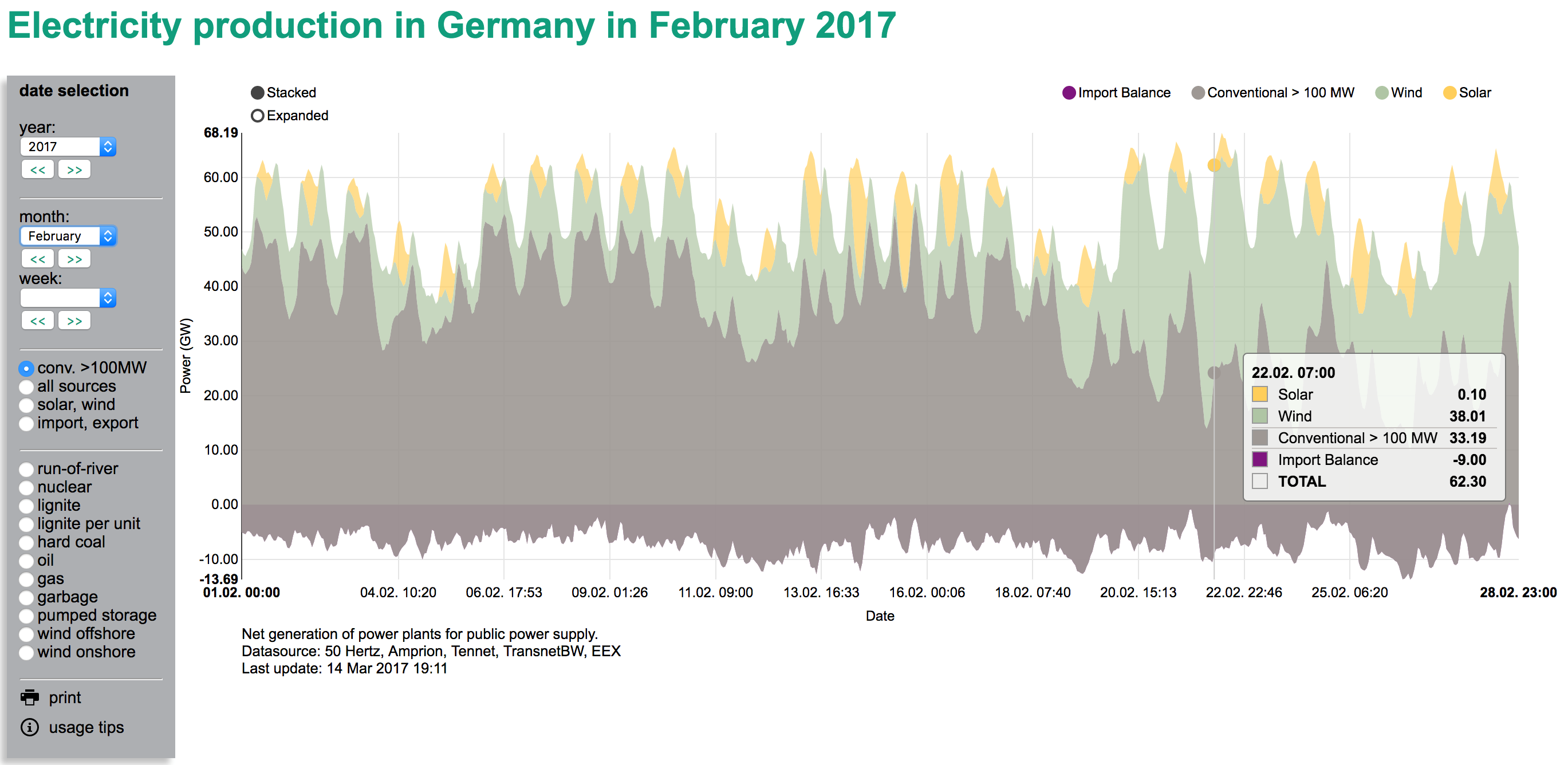Last Friday, an Indian airliner passing over Europe lost radio contact and had to be escorted by fighter jets (it could have been a terrorist attack). As the plane passed over German reactors, some were evacuated just in case. None of them were generating power at the time. Wind power, in contrast, was strong across Europe – and there’s a downside to that, too. Craig Morris explains why.

Philippsburg 2 has been off since 2016, when an emergency system failed (Photo by Michael Kauffmann, edited, CC BY 2.0 DE)
The plane lost radio contact over Hungary and was directed back to London. Czech military jets escorted it into Germany, where German fighter planes continued the escort to the Belgian border. The plane reportedly had restored radio contact by the time it entered British airspace; a spokesperson for Air India said the failure was due to “frequency fluctuation.”
As the plane passed near six reactors in Germany, staff were evacuated, aside from the Krümmel reactor, where people were put in protected rooms (report in German). These precautionary measures – called a Renegade Pre-Alarm – were implemented in 2003 in reaction to 9/11. There was concern that terrorists might have hijacked the plane in order to crash it into a nuclear plant. None of the six reactors were generating power at the time. Several of them are already being phased out; staff are still on hand there for dismantling.
Of the eight remaining reactors in Germany, Brokdorf and Grohnde were offline for scheduled maintenance at the time. Only five of the eight reactors still in operation in Germany produce electricity at the moment. Philippsburg 2 has been off since December 2016, when an emergency system failed.
The chart below shows the situation in February. Here again, only five reactors were available most of the time. Gundremmingen B, which is to be closed for good at the end of this year, shut down for its last refueling in early February; at the end of the month, you can see the failed attempt to restart the reactor (dark green area in the chart below). It went back into normal operation a week later.
At Gundremmingen, the problem was a faulty valve, which was fixed. At Brokdorf, the fuel rods are rusting twice as fast as normal, and no one knows why. Until the matter has been clarified, the reactor could stay offline. The environmental minister of the state of Schleswig-Holstein (Robert Habeck, a Green Party member) will ultimately decide.
Spot prices up
Overall, the shortfall in nuclear power production has raised prices on the exchange. In January, when 5 to 7 of the eight reactors were in operation (depending on the day), the spot price averaged 5.2 cents per kWh, a whopping 82 percent higher than in the previous January (report in German). Part of the reason was the partial failure of France’s nuclear fleet; there, the price of power was up 132 percent in January 2017 relative to January 2016. In February, prices dropped slightly but remained 79 percent above the level of the previous February (report in German).
For power sellers, the higher spot prices are good news – but also for those who pay the renewable energy surcharge. Remember: the difference between feed-in tariffs paid to green power producers and revenue from the sale of that power on the spot exchange accrues in the surcharge account. Higher spot prices mean the difference – and hence the surcharge – is smaller. Credit on the account grew by more than a billion euros in February, the largest increase since the current accounting system was launched in 2010 (report in German).
In addition to the shortfall in nuclear power, wind power production was strong in February, surpassing 10 TWh for only the third time in history. And on Feb 22, wind power reached 38 GW briefly, far above the old record of 35.7 GW from January.
The winds were blowing strongly across Europe that day.
Wind supplied yesterday 94% of Denmark’s power, Ireland 48%, Portugal 39%, Germany 38%, Lithuania 24% Poland 23%: https://t.co/7og44dghSo
— Felix Chr. Matthes (@felixmatthes) February 22, 2017
In a way, that’s bad news, though renewable energy proponents like Öko-Institut’s Felix Matthes (tweet above) mainly celebrate the event as the achievement it certainly also is.
But ideally, we would want a more balanced wind profile across the continent, not simultaneous records everywhere. As wind power continues to grow, countries will want to export wind power to a neighbor, where the wind isn’t blowing. Unfortunately, it tends to be windy in all of Europe at once.
Craig Morris (@PPchef) is the lead author of Global Energy Transition. He is co-author of Energy Democracy, the first history of Germany’s Energiewende, and is currently Senior Fellow at the IASS.


When you’re saying that it’s windy in all of Europe, that also means that there’s no geographical solution for the infamous Dunkelfaute?
Yes
“It tends to be windy in all of Europe at once.” What’s the diameter of a typical anticyclone? 2000 km? It seems implausible that you should get the same conditions in Ireland and Poland at the same time. There is a benefit to the European supply system as a whole to have real geographic depth. Ireland and Portugal are doing their windy bit here – but Poland is not. Adding Russia gives you as much depth as you could ask for, but Putin won’t cooperate.
Latest wind power record was set last Saturday (18.3.2016) with 38.5 GW
https://www.energy-charts.de/power.htm
Text in German:
http://www.iwr.de/news.php?id=33313
One for the atom clown’s laughing s(t)ocks:
Swiss atom power plant Beznau1 will be fired up after 2 years of break down, it is the oldest atom power plant in the world. “The most experienced ” as the owner calls it.
For one day (!), the first of May, international laborer’s day:
http://www.reuters.com/article/switzerland-nuclear-idUSL5N1GX1XE
The owner of the miracle machine used a replica piece of steel to test it’s integrity
http://www.world-nuclear-news.org/RS-Replica-vessel-component-used-to-verify-Beznau-1-safety-1409165.html
The foundry Creussot where the original reactor pressure vessel was made is since two years cold,out of order(s).
Imagine your doctor uses a replica to test your heart beat …:) but not a whole heart replica, just a flap from a replica whos manufacturer is dead since 2 years …..
[…] yet another wind power record, with production peaking at 38.5 GW on March 18, just topping the old record of 38 GW on February 22. The month as a whole was the biggest ever for renewables in the country as […]
[…] yet another wind power record, with production peaking at 38.5 GW on March 18, just topping the old record of 38 GW on February 22. The month as a whole was the biggest ever for renewables in the country […]
[…] March, Germany peaked with wind power production record at 38.5 GW on March 18, just topping the old record of 38 GW on February […]
[…] Marzo c’e’ stato in record della produzione, con Eolo che regalava 38.5 GW di energia. Il record precedente era arrivato il 22 Febbraio 2017, poche settimane prima, segno che siamo in fase continua di crescita. E’ cresciuto anche il […]
[…] Il 18 Marzo c’e’ stato in record della produzione, con Eolo che regalava 38.5 GW di energia. Il record precedente era arrivato il 22 Febbraio 2017, poche settimane prima, segno che siamo in fase continua di […]